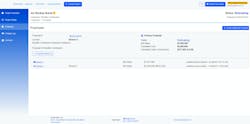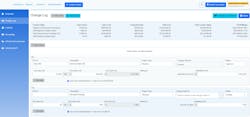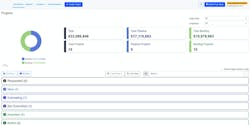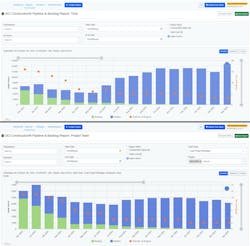Using Business Software to Manage Your Manpower Needs
It’s nearly impossible today to think of starting a business without software tools. We use software to manage our data, perform record-keeping services, and support our decision making. But for any software system to assist with management decision making and true projection/forecasting in a way that is useful, it must have real-time access to the same data from all the sources you utilize.
When you choose an integrated software suite that provides customer relationship management (CRM), estimating, project management, project cost accounting, and high-level ERP functions in one program, you believe that you have all the information needed to track and project reliably — but perhaps not.
What about all the telephone calls and emails that ultimately impact your scope of work and your timeline for completion? How does your integrated software account for changes in work, not just cost? You need to have direct operational input to know how change orders, alternate means and methods, material substitutions, and revised schedules impact your work/labor needs — not to mention productivity impacts, rework, and how interrupted installation progress will come into play.
owever, there is a way you can pull all these disparate data silos into one place and eliminate the “noise” and redundancy, then accurately evaluate completion rate and productivity to arrive at a reliable projection of labor needs for your jobs and your business.
Choosing the correct business software
If you consider what’s happening — and what the software is doing — it isn’t necessarily advantageous to integrate all the business functions in a single suite and leave out the critical operational input. The key to looking forward and developing a forecast for the future requires the tighter interconnection of the estimators’ and procurement managers’ negotiations and the job-site operational performance decisions of the installation team. While we’re making these connections, let’s not overlook the impacts of production schedules, supply chain delays, and other trades interfering with the installation timeline.
To utilize a high level of digital management support through information technology, your information must be digitized for use by any program. Your data can then be structured in a way that it can be synchronized (or interconnected in time) between multiple sources and multiple functions. This digitalization and interconnection of data is not dependent on a specific source program or integrated accounting-based software suite. It must reach outside of those tools and provide a platform for real-time operational inputs. Only with the interconnection of all those negotiations, verbal exchanges, official, and unofficial but active schedule and contract changes can an accurate pipeline and backlog be generated — and subsequently used to project future workload.
Unfortunately, knowing the workload still isn’t enough. Getting from work to manpower projection requires one more significant bit of information: productivity trends. That means not just the rearview of ‘What did I do, and how many hours were required?’ but also the forward-looking projection tells us what work remains at our realized productivity levels. After this inclusion, you can determine how much manpower the project is going to require.
ASTM Standard E2691
ASTM offers a job productivity measurement standard (ASTM Standard E2691) that can provide the only recognized means to effectively gather and develop productivity trends, accurately forecast the real burn rate of the work, and subsequently project labor and manpower needs for all known current and future jobs.
Let’s look at an example to further explain this line of thinking.
A contractor with annual sales of roughly $25 million has a current backlog and pipeline of $16 million to $20 million. This number is always changing and requires a structured tool to maintain a real-time value, while both installation progress and estimating awards are updated regularly. For this example, software is used to provide the interconnection of source data. Source data can be interconnected or manually entered from the estimate summary to provide an initial contract value and related labor requirements. Figure 1 provides a screenshot of the information that is included.
As the contract is negotiated and updated during preconstruction and early construction, the estimator can manually track the status of all proposed alternates and changes using the changelog functionality that is displayed in Fig. 2. The change log allows for recognizing multiple and partial changes and award statuses. The only accurate source for this information is from the people who create, negotiate, accept, and perform it. With the information tracked in the project cards for each project manager, company division, and the overall company, a complete pipeline and backlog report can be generated.
Figure 3 shows the high-level dashboard reporting the value of the pipeline and backlog. Additionally, these values can be broken down to see current and future work by division or by project manager.
The bad news is this still isn’t enough information to project your future manpower needs. You need to be able to accurately identify the burn rate at a realistic productivity level. Using work order management software modules (JPAC® and SIS®), electronic interconnections update the remaining backlog in real-time and project the future labor hours to complete the remaining backlog. Figure 4 shows these projections for a sample company.
Having the capability to monitor contract changes as they occur and review bid alternates and proposed change orders/labor impacts of revised schedules in a single projection, regardless of the type of work you do, the type of contracts you sign, who your customers are, and which accounting program you selected has always been the goal of business owners. Extending the projections and overlapping project labor needs require real-time updates to remaining work at current productivity trends. This example uses DCI Construction® software with interconnection with JPAC® and SIS® along with any available accounting, estimating, project management, scheduling, and CRM tools you may already have in place.
Summary
By analyzing data from all available sources, we can accurately project manpower needs for as far into the future as you can reliably anticipate the work you’re going to contract. For many smaller and growing contractors, the resources and talent needed to realize these results will also require additional investment in staffing, training, and/or outside support. Investment to grow and to grow profitably is all part of the same labor and resource planning and projection.
About the Author
Phil Nimmo, MCA, Inc.
Phil Nimmo is vice president of business development at MCA, Inc. He can be reached at [email protected].




